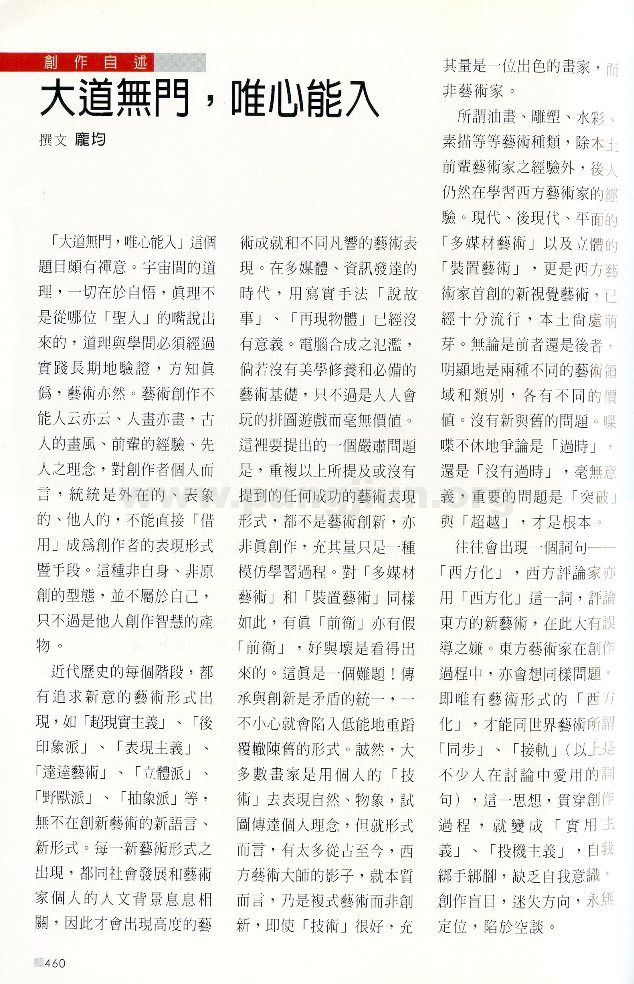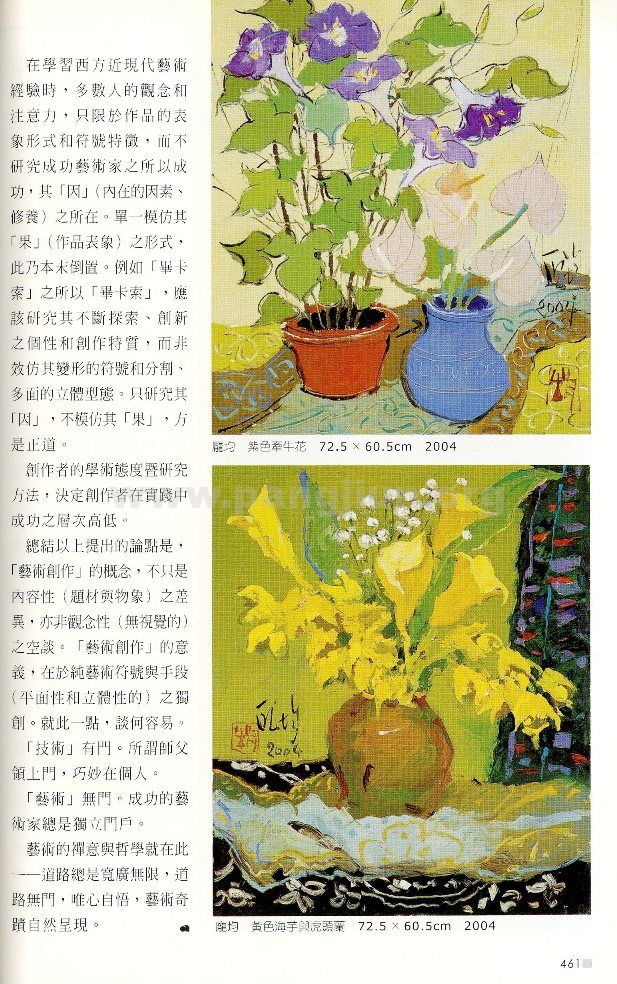 CLOSE
CLOSE
“Tao (The Way) has no door, and only the heart knows where it is.” This interesting title has a Zen-feel to it. The truth of the universe lies in self-awareness. Truth is not told by any “saint,” and truth and knowledge come from practice and time. Similarly, art cannot be practiced by blindly following what others have said and painted. The styles of ancient painters, the experiences of predeceased artists, and the ideas accumulated through generations, are external, superficial, and foreign to practicing artists, and cannot be directly “borrowed” to become their own forms and styles. Not originally conceived by the artists themselves, these forms and styles are the wisdom of others.
At every stage of modern history, there has been innovative art forms. Surrealism, post-Impressionism, Expressionism, Dada, Cubism, Fauvism, and abstract art are all examples that have revolutionized the form of art. Every art form that emerges is closely related to the social context of the time, as well as the personal background of the artists themselves. This is what results in great leaps in artistic achievement and expression. In the age of technology and information, it has become meaningless to use realism to “tell stories” and “reproduce objects.” Without aesthetic cultivation, the proliferation of computer synthesis is nothing more than a jigsaw puzzle that anyone can play at. A serious point to be put forth here: to copy the above-mentioned or any other non-mentioned successful art form is not artistic innovation; it is at best, a process of imitative learning. The same can be said of “multimedia art” and “installation art:” some are true “avant-garde,” some are false. You are able to distinguish the good from the bad. This is indeed a real problem! Legacy and innovation is the unity of contradictions, and if one is not careful, one can easily fall into the cycle of repetition. Even though most painters use personal “techniques” to express nature and objects in an attempt to convey personal ideas, their works still contain shadows of their great Western predecessors. They are essentially mimicking art; their techniques may be great, but they are at best excellent painters, not real artists.
When it comes to oil painting, sculpting, water color, sketching, and other types of art, aside from some local senior artists, latter generations are still learning from Western predecessors. In our modern and post-modern world, two-dimensional “multimedia art” and three-dimensional “installation art,” art forms pioneered by Western artists, are now becoming very popular in Taiwan. No matter the former or the latter, they are obviously two different art fields, each with distinctive values. The point is not about old and new; it is meaningless to debate if it is “obsolete” or “not obsolete.” “Breakthrough” and “transcendence” are what is fundamental.
Western critics often use the term “Westernization” to comment on new works by Eastern artists, but this may be misleading. As Eastern artists create, they are preoccupied with the notion that they must “Westernize” their forms in order to “keep pace with” or “synchronize with” (these are common expressions in the related discussion) international art. This idea is “pragmatic” and “opportunistic,” but confines the artist, blinds his creativity, disorients his direction, and traps him without a purpose.
In learning from modern Western art, most people focus only on the external forms and symbolic features of a piece of work, without regard to the reason why the artist became successful. To imitate the “results” of their ideas (works) is to put the cart before the horse. Take Pablo Picasso for example. What should be studied are his exploratory methods, innovative spirit, and creative qualities, and not how to achieve the effects of his distorted signs and fragments, nor his multifaceted, cubist objects. The right thing to do is to inquire into the “origins,” not to replicate the “results.”
An artist’s academic attitude and research methods determine his level of success.
To sum up, art creation involves neither simply the differentiation of content (subject and signs), nor empty talks about concepts (unrelated to visual arts). The significance of art lies in the creation of pure art signs and (two- and three-dimensional) media. This is not an easy task.
As the saying goes, “techniques” have a door, and one can be led to the door by a master, but one cannot be forced to knock.
“Art” has no door. Successful artists find their way.
The Zen philosophy of art is that: Tao (the Way) is always wide and boundless, but it has no door, and only the heart knows how to get there. The miracle of art occurs naturally.

